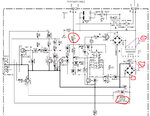Zaccoh
Newbie level 6
Hi all, hope everyone is safe and well.
I have been trying to troubleshoot the power supply circuit on my yamaha amp, I replaced the capacitor c405 as I read it was a common issue with the rxv models but it still won't turn on. I'm getting 240vac at the supply and at the ac outlet, 180mv ac at cb402, similar reading at d405 and 0.36vdc across pins 14 and 7 of the IC.
Can anyone shed some light on what might be the issue? I'm a sparky by trade but have almost no experience with electronics, I read a similar post here and was hoping someone might have more of an idea than me.
Cheers.
I have been trying to troubleshoot the power supply circuit on my yamaha amp, I replaced the capacitor c405 as I read it was a common issue with the rxv models but it still won't turn on. I'm getting 240vac at the supply and at the ac outlet, 180mv ac at cb402, similar reading at d405 and 0.36vdc across pins 14 and 7 of the IC.
Can anyone shed some light on what might be the issue? I'm a sparky by trade but have almost no experience with electronics, I read a similar post here and was hoping someone might have more of an idea than me.
Cheers.
